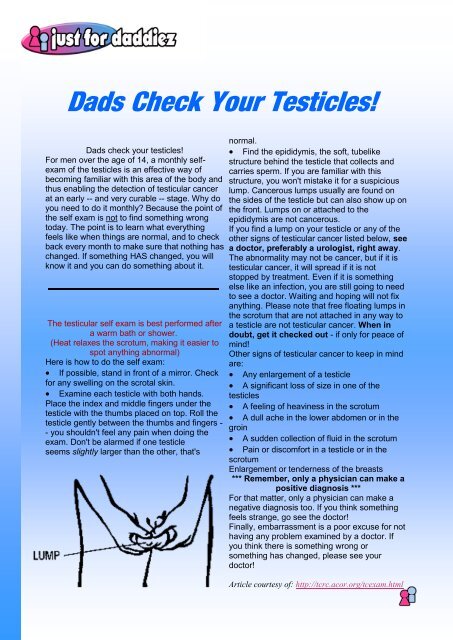mummiez & daddiez magazine May - June Issue 2013
Create successful ePaper yourself
Turn your PDF publications into a flip-book with our unique Google optimized e-Paper software.
Dads Check Your Testicles!<br />
Dads check your testicles!<br />
For men over the age of 14, a monthly selfexam<br />
of the testicles is an effective way of<br />
becoming familiar with this area of the body and<br />
thus enabling the detection of testicular cancer<br />
at an early -- and very curable -- stage. Why do<br />
you need to do it monthly? Because the point of<br />
the self exam is not to find something wrong<br />
today. The point is to learn what everything<br />
feels like when things are normal, and to check<br />
back every month to make sure that nothing has<br />
changed. If something HAS changed, you will<br />
know it and you can do something about it.<br />
The testicular self exam is best performed after<br />
a warm bath or shower.<br />
(Heat relaxes the scrotum, making it easier to<br />
spot anything abnormal)<br />
Here is how to do the self exam:<br />
If possible, stand in front of a mirror. Check<br />
for any swelling on the scrotal skin.<br />
Examine each testicle with both hands.<br />
Place the index and middle fingers under the<br />
testicle with the thumbs placed on top. Roll the<br />
testicle gently between the thumbs and fingers -<br />
- you shouldn't feel any pain when doing the<br />
exam. Don't be alarmed if one testicle<br />
seems slightly larger than the other, that's<br />
normal.<br />
Find the epididymis, the soft, tubelike<br />
structure behind the testicle that collects and<br />
carries sperm. If you are familiar with this<br />
structure, you won't mistake it for a suspicious<br />
lump. Cancerous lumps usually are found on<br />
the sides of the testicle but can also show up on<br />
the front. Lumps on or attached to the<br />
epididymis are not cancerous.<br />
If you find a lump on your testicle or any of the<br />
other signs of testicular cancer listed below, see<br />
a doctor, preferably a urologist, right away.<br />
The abnormality may not be cancer, but if it is<br />
testicular cancer, it will spread if it is not<br />
stopped by treatment. Even if it is something<br />
else like an infection, you are still going to need<br />
to see a doctor. Waiting and hoping will not fix<br />
anything. Please note that free floating lumps in<br />
the scrotum that are not attached in any way to<br />
a testicle are not testicular cancer. When in<br />
doubt, get it checked out - if only for peace of<br />
mind!<br />
Other signs of testicular cancer to keep in mind<br />
are:<br />
Any enlargement of a testicle<br />
A significant loss of size in one of the<br />
testicles<br />
A feeling of heaviness in the scrotum<br />
A dull ache in the lower abdomen or in the<br />
groin<br />
A sudden collection of fluid in the scrotum<br />
Pain or discomfort in a testicle or in the<br />
scrotum<br />
Enlargement or tenderness of the breasts<br />
*** Remember, only a physician can make a<br />
positive diagnosis ***<br />
For that matter, only a physician can make a<br />
negative diagnosis too. If you think something<br />
feels strange, go see the doctor!<br />
Finally, embarrassment is a poor excuse for not<br />
having any problem examined by a doctor. If<br />
you think there is something wrong or<br />
something has changed, please see your<br />
doctor!<br />
Article courtesy of: http://tcrc.acor.org/tcexam.html






